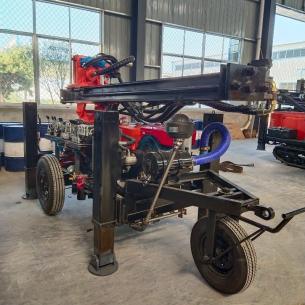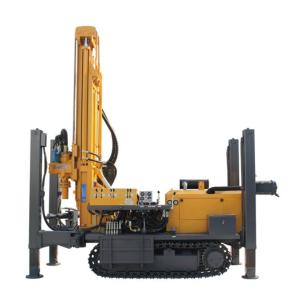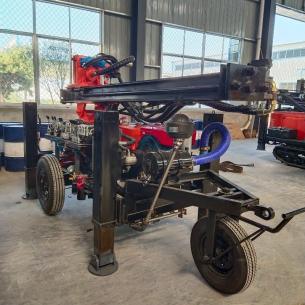Classification of Well Drilling Rig
Generally, there are three types of rotary drilling rig, impact drilling rig and composite drilling rig.
Rotary drill
The hole is formed by breaking the rock stratum by the rotary motion of the drilling tool. It mainly includes large and small pot cone drills, positive and reverse circulation rotary table drills, and hydraulic power head drills machine, down-the-hole vibration rotary drill, etc. A simple rotary drill has only a drilling device, while a well-structured rotary drill consists of a drilling device and a circulating well flushing device. The drilling tool of rotary well drilling rig includes drill pipe and drill bit. The nominal diameters of commonly used drill pipes are 60, 73, 89 and 114 mm. The drill bits are divided into two types: full drill bit and annular drill bit. Large and small pot cones use their pot cone drilling tools to rotate and cut the soil layer. According to the size of the drilling tool, they are called big pot cone and small pot cone, which can be driven by manpower or power. The cut soil scraps fall into the pot and are lifted to the ground for unloading. Its structure is simple and its work efficiency is low. It can only be used in general soil layers or layers with a diameter of no more than 10 cm and a content of no more than 50%. The hole diameter of the small pot cone is 0.55m, and the drilling depth is 80-100m; The hole diameter of the big pot cone is 1.1 meters, and the drilling depth is 30-40 meters. The rotary drilling rig (Fig. 1) is commonly used for the rotary drilling rig of positive and reverse circulation mud washing, that is, the rotary drilling rig of positive circulation mud washing consists of tower, winch, rotary table, drilling tool, mud pump, swivel and motor. During operation, the power machine drives the rotary table through the transmission device, and the active drill pipe drives the drill bit to rotate and break the rock stratum at a speed of 30~90 rpm. After being pumped and pressurized by the mud pump, the mud is pressed into the hollow drill pipe through the faucet above the drill pipe, flows downward into the drill bit, and is ejected from the nozzle to cool and lubricate the drill bit; The cuttings at the bottom of the well are brought out of the wellhead through the annular channel outside the drill pipe. After settling in the sedimentation tank, the mud flows back to the mud pool for recycling. The drilling method and structure of the reverse circulation mud washing rotary drilling rig are basically the same as the above, but the mud circulation mode is opposite: the mud flows into the bottom of the well from the wellhead after settling in the sedimentation tank, and the mud carrying rock cuttings is pumped out of the well through the drill pipe cavity through the bit nozzle by the sand pump, and then returns to the sedimentation tank. This method is called pumping reverse circulation. Water pump can also be used to inject pressurized water from the bottom of the well into the inner cavity of the drill pipe through the nozzle to form an upward flow carrying rock cuttings, which is called jet reverse circulation. The drill can form a high rising velocity in the drill pipe, and has a strong ability to discharge rock cuttings and pebbles, so the drilling speed is faster. It is applicable to soil layer, general sand layer and loose stratum with pebble diameter smaller than the inner diameter of drill pipe. The inner diameter of drill pipe used is relatively large, generally 150~200mm, and the maximum can reach 300mm. However, due to the limitation of the pumping or pumping capacity of the pump, the drilling depth is generally less than 150 meters, and the cuttings removal efficiency is higher when the well depth is less than 50 meters. The rotary table drilling rig for pressure gas well flushing uses air compressor instead of mud pump and compressed air instead of mud for well flushing. Generally, reverse circulation is adopted, also known as gas-lift reverse circulation (Figure 2). That is, compressed air is sent to the gas-water mixing chamber in the well through the gas supply pipeline to mix with the water flow in the drill pipe to form aerated water flow with a specific gravity of less than 1. Under the gravity of the annular water column around the drill pipe, the aerated water flow in the drill pipe with rock cuttings continuously rises and flows out of the well into the sedimentation tank, and the settled water flows back into the well by gravity. When the well depth is large (more than 50 meters), the cuttings removal capacity of the drilling rig is greater than that of the drilling rig with pumping or jet reverse circulation, so it is suitable for the situation of large well depth, dry areas with water shortage, and frozen soil layer in cold zone.
Some rotary drilling rigs are equipped with mud pump and air compressor at the same time, and different well flushing methods can be selected according to the situation.
Hydraulic power head drill is a kind of rotary drill. It is driven by the hydraulic motor through the reducer, and the rotary table and faucet on the rotary table drill are replaced by the power head moving up and down along the tower to drive the drill pipe and drill bit to rotate and cut the rock stratum. Large-diameter water wells can be drilled with a large drill bit with a diameter of up to 1 meter, which is characterized by fast drilling speed, easy loading and unloading of the drilling tool and lowering of the well pipe, no need to lift the drilling tool when lengthening the drill pipe, and a series of components such as winch, lifting pulley, rotary table, faucet, and kelly are simply avoided. Down-the-hole vibration rotary drill is a kind of rotary drill that drills rock stratum by combining vibration and rotary motion. The drilling tool is composed of drill bit, vibrator, vibration damper and guide barrel (Fig. 3). The exciting force generated by the vibrator makes the whole drilling tool move in a conical swing. The drill bit is sleeved on the outside of the vibrator shell through the friction ring. On the one hand, it vibrates with the vibrator in a horizontal circular vibration with a frequency of about 1000 rpm and an amplitude of about 9 mm; On the other hand, it makes a low-speed rotation movement of 3~12 rpm around the vibrator axis to break the rock stratum, while the drill pipe does not rotate, and uses the vibration damper to avoid transmitting the vibration to the drill pipe. The compressed air reverse circulation method is used to wash the well, so that the cuttings are discharged out of the well through the conduit and drill pipe cavity located in the center of the vibrator. This drill has simple structure and high drilling efficiency. The hole diameter is about 600mm, and the drilling depth can reach 150m.



